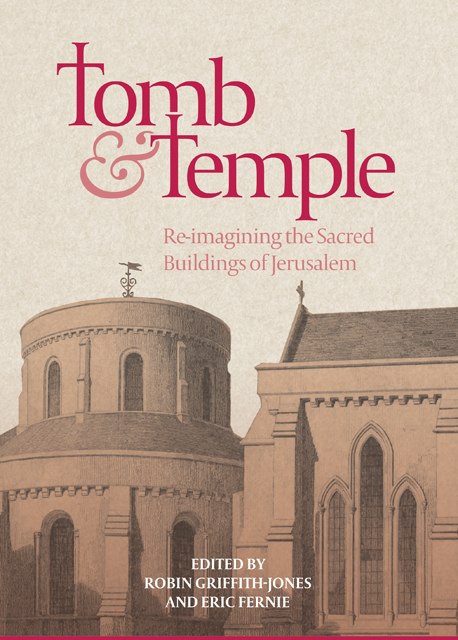Book contents
- Frontmatter
- Contents
- Illustrations
- Preface
- Contributors
- Abbreviations
- Editors’ Note
- Introduction
- Part I Re-presenting Jerusalem
- Part II The Church of the Holy Sepulchre
- Part III The Noble Sanctuary / The Temple Mount
- Part IV The Orthodox Churches
- Part V Round Churches in the West
- Appendix: The Knights’ Effigies: Newly Discovered Drawings by John Guillim, c. 1610
- Epilogue
- Index
- Already Published
2 - The Building of the Holy Sepulchre
Published online by Cambridge University Press: 17 January 2023
- Frontmatter
- Contents
- Illustrations
- Preface
- Contributors
- Abbreviations
- Editors’ Note
- Introduction
- Part I Re-presenting Jerusalem
- Part II The Church of the Holy Sepulchre
- Part III The Noble Sanctuary / The Temple Mount
- Part IV The Orthodox Churches
- Part V Round Churches in the West
- Appendix: The Knights’ Effigies: Newly Discovered Drawings by John Guillim, c. 1610
- Epilogue
- Index
- Already Published
Summary
From Jerusalem To Aelia Capitolina
The first building that calls for our attention is the Holy Sepulchre as it was built by Constantine and perhaps finished by Constantius II. We need a brief survey of the literary and archaeological evidence in order to do justice, in the chapter’s second half, to the status implied by the building for Christ and for Constantine.
Jesus was crucified in April 30 or 33 CE. Joan Taylor has shown that ‘Golgotha’ was the area of a disused quarry just outside and to the north of the Gennath (Gardens) Gate. She argues that the site of Jesus’ tomb identified under Constantine, some 250m north of the gate, was authentic; but that Jesus had been crucified at the quarry’s southern end, immediately outside the gate on a spot prominently visible from two roads, leading west to Emmaus and Joppa, and north to Samaria. (Crucifixion was designedly public; it was a deterrent.) Fig. 2.2 shows a tomb in Bethany, of the kind likely to have been used for Jesus: a rock between the vestibule and kokhim-chamber will have kept out scavenging animals; kokhim or horizontal shafts were dug for several bodies in the central chamber, and on use will have been plugged with stone; the arcosolium was ready for the ultimate deposit of bones. Jesus was buried in haste by frightened followers; his body was probably left, as a temporary measure, on such a ledge as shown here in the chamber beneath the kokhim. Jerusalem’s walls were rebuilt and extended by Agrippa I between 41 and 44 CE; the quarry was now enclosed within the city.
In 70 CE, at the end of the Jewish rebellion against Rome, Jerusalem was sacked and the Temple destroyed. At least some Jewish life continued in and around the city. En route to Egypt, between 129 and 130 CE, the Emperor Hadrian (Publius Aelius Hadrianus) was adorning cities and celebrating games. Within this programme he determined to rebuild Jerusalem and to rename it Colonia Aelia Capitolina. According to a later summary of Dio Cassius, ‘in the place of the temple of the god he set up in opposition a new temple to Zeus’, and this triggered a second Jewish revolt. Archaeological finds confirm the extent of the destruction wrought in the revolt’s suppression between 132 and 135. Hadrian then expelled the Jews from the city.
- Type
- Chapter
- Information
- Tomb and TempleRe-imagining the Sacred Buildings of Jerusalem, pp. 53 - 75Publisher: Boydell & BrewerPrint publication year: 2018
- 1
- Cited by



